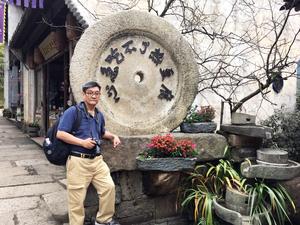Editor’s note: As China aims to eliminate extreme poverty and be a “moderately prosperous society” (xiaokang shehui) in time for the 100th anniversary of the founding of the Communist Party of China next year, we talk to leading experts for their take on the country’s commitment.
 Grains are put out to dry on traditional mats in the village of Huangling. The settlement in Wuyuan county, Jiangxi province, boasts 600 years of history, and the scenic area is now a prime example of how rural tourism benefits remote communities, according to Koh King Kee. (HU CHENHUAN / XINHUA)
Grains are put out to dry on traditional mats in the village of Huangling. The settlement in Wuyuan county, Jiangxi province, boasts 600 years of history, and the scenic area is now a prime example of how rural tourism benefits remote communities, according to Koh King Kee. (HU CHENHUAN / XINHUA)
The imagery that sticks in Koh King Kee’s mind from a visit to China 31 years ago is of the country as a wild horse. The Malaysian was making his first study tour of China, covering a sweep of territory that took him from Beijing in the north to Hainan province in the south. On that spring visit, he wanted to better understand China’s reform and opening-up experience.
Returning home, he told a Malaysian newspaper in an interview: “China is a wild horse, full of vigor and galloping swiftly forward. Although the pace may be disorderly at times, it will never turn back.”
Three decades later, China has become “a high-speed train on solid tracks with a clear direction, and is traveling at tremendous speed”, said Koh, president of the Centre for New Inclusive Asia, a think tank in Kuala Lumpur, Malaysia.
Though China’s remarkable economic transformation has impressed the world, with the country emerging from poverty to become the second-largest economy within 40 years, there are gaps in how outsiders perceive this journey.
For most, understanding and knowledge of China’s poverty-alleviation efforts and achievements remain insufficient, said Koh, a keen observer of political and economic developments in China.
Since China began to reform and open up its economy in 1978, growth in gross domestic product has averaged almost 10 percent a year, and more than 850 million people have been lifted out of poverty, according to the World Bank. This figure represents about 70 percent of the gains made by the entire world in poverty reduction over that period.
“China’s achievements in poverty alleviation are outstanding, and China can share its experiences on poverty reduction with more developing countries across the world.”
Koh said it would be good to see even more work being done on this front.
Poverty reduction has always been a priority for Chinese President Xi Jinping. The country aims to fully eradicate poverty by the end of this year, a goal that is a key component of the plan to build China into a moderately prosperous society in all respects.
Xi also writes about poverty alleviation in his book, Up and Out of Poverty, based on his grassroots working experience from his early years.
“It is a very good practice to raise poverty alleviation to become a strategic goal of the country, and it is also important for the country to hold a vision that every person should benefit during the process of industrialization and to extend a helping hand to those who need it,” Koh said.
 Pools of water amid the otherwise arid landscape of a desert in Alashan make for a snap-happy tourist’s dream in this part of the Inner Mongolia autonomous region. (WANG ZHENG / FOR CHINA DAILY)
Pools of water amid the otherwise arid landscape of a desert in Alashan make for a snap-happy tourist’s dream in this part of the Inner Mongolia autonomous region. (WANG ZHENG / FOR CHINA DAILY)
He said the guiding principle behind China’s efforts to eradicate poverty is targeted poverty alleviation, which means applying development measures tailored for local conditions after careful study of the causes of poverty. The principle also entails exploring the scope for potential activities that could be pursued to improve people’s living standards.
China’s local governments even craft tailor-made programs to help individuals and families rise out of poverty based on the specific causes that have been identified for their conditions.
“Targeted poverty alleviation is an important strategy that China has adopted and the one lesson that the world should learn the most,” Koh said. “The causes of poverty in every region, and even within every family, can be very different. If the government offers a one-size-fits-all measure to help the poor, it could be ineffective and may end up creating wastage.”
Koh said a lack of developed transport networks could be a factor that holds back some regions, while others have large tracts of barren land that are unsuitable for growing crops.
At the level of individuals, some may fall into poverty due to illness, while old age and the inability to keep working can plunge others into hardship. Similarly, a lack of education or adequate work skills holds many back.
In terms of remedies, Koh said he is deeply impressed by China’s use of technology to aid the poor.
Drones are used to help farmers with aerial spraying of pesticides. Big data is employed to help identify the causes of poverty in communities, and e-commerce platforms provide a means for farmers to sell more of their agricultural produce.
Given that the vast majority of poor Chinese live in the countryside, the government has heavily promoted the use of e-commerce in villages as a means of opening new sales channels and accelerating automation in agricultural production.
Online platforms are seen as a way to overcome the problem of villagers’ limited access to information, which has hindered economic progress.
The development of internet infrastructure in the countryside, along with programs to train people in e-commerce skills, is being promoted as a means to help the rural poor boost incomes.
The government has also called on large companies to make comprehensive e-commerce platforms available for the benefit of people in rural areas.
According to the Ministry of Commerce, the value of online sales of agricultural products was 397.5 billion yuan (US$56.1 billion) last year, up 27 percent year on year. The number of online sellers in rural areas rose to 13.84 million, with the ranks of rural internet users exceeding 250 million, the ministry said.
“China’s agriculture products are now sold to urban folks through e-commerce, an experience worth learning by other developing countries,” Koh said.
“Earlier in the COVID-19 pandemic, Kenya’s coffee-bean farmers were unable to sell their produce due to transportation restrictions. However, they were later able to sell all their coffee beans through the platforms of the Chinese e-commerce giant Alibaba.”
 Koh King Kee in Wuyuan county, Jiangxi province, in 2017. (PHOTO PROVIDED TO CHINA DAILY)
Koh King Kee in Wuyuan county, Jiangxi province, in 2017. (PHOTO PROVIDED TO CHINA DAILY)
Mirroring the situation in China, countries in Southeast Asia, including Indonesia, Malaysia and the Philippines, have higher proportions of poor people in remote rural areas. As in rural China, low education levels contribute to the hardships they face.
“I have suggested to Malaysian government officials that they reach out to China and learn from China’s poverty-alleviation experiences,” Koh said.
“This may prove useful in our efforts to reduce rural poverty. We cannot emulate all the practices that China does, as we have our own specific causes of poverty in Malaysia, but we can learn from China’s best practices and strategies in lifting people out of poverty.”
Koh pointed to the concentrations of poverty among some of the indigenous peoples of Malaysia’s eastern states. He believes their lives could be improved with a focus on activities such as making eye-catching traditional handicrafts. In their midst, there is also an abundance of therapeutic herbs in the forests.
Sales of handicrafts and sought-after herbs could be boosted through online promotions.
“Most countries do not have long-term strategies for poverty alleviation, set quantifiable national targets or have the resolve to solve the problem in a specific time frame as with China,” he said.
“These governments do not have the system advantage that China has in mobilizing state resources to help the poor.”
Koh applauds China for putting green-based development high on the economic agenda, while authorities introduce poverty-alleviation measures.
He cites the northern desert areas of the Inner Mongolia autonomous region, where officials have helped residents to increase their incomes by encouraging them to grow anti-desertification plants, which have an added benefit of helping to make the desert green.
Koh recalls what he learned from a 2017 visit to Wuyuan county in eastern China’s Jiangxi province, where he was struck by the picturesque rural scenery. “The local government has increased farmers’ income by developing rural tourism,” he said.
“The well-preserved ancient villages and natural scenery such as the bridges and rivers are splendid.”
Koh stresses that governments should realize that poverty is hardly likely to be eradicated with a one-time solution; follow-up actions are required.
“People who have just risen out of poverty can fall into poverty again due to natural disasters, illnesses or other problems. Shaking off poverty is not the end, and people still have a long way to go before they can live a prosperous life. In China, local governments set up a monitoring system to ensure that people lifted out of poverty don’t fall back into the poverty trap.”
Koh said that despite the differences — in levels of economic development, cultural attitudes and policy approaches — countries worldwide can learn from China’s experience in reducing poverty.
He suggests that China set up a special agency under the Belt and Road Initiative in which resources are made available for the nation to share its experiences with developing countries.
In particular, he has in mind Africa and the less-developed countries in Southeast Asia. Such an agency could help governments look more effectively into their poverty situation and apply remedies with a clearer focus on the issues.
“China has financed and constructed many large infrastructure projects in developing countries under the BRI, which will no doubt boost partner countries’ economic growth in the long run. But China also needs to look into projects that can yield more immediate results and bring direct benefits to improve local people’s living standards.”
He suggested for China to invite more people — government officials, community leaders, NGO representatives and scholars — to visit poverty-alleviation projects in the country.
In this way, they can observe firsthand the best practices that China employs in the battle against deprivation. They will be equipped with the knowledge and insights to apply these methods in those areas of need in their own countries.
Koh said China’s experience in lifting up its people has become even more relevant to the world, given the rise in extreme poverty caused by the COVID-19 pandemic.
According to research by the United Nations University World Institute for Development Economics Research, rates of extreme poverty could rise to affect more than 1 billion people due to the pandemic.
“Poverty is likely to increase dramatically in middle-income developing countries and there could be a significant change in the distribution of global poverty,” the research paper said. “The location of global poverty could shift back toward developing countries in South Asia and East Asia.”
Despite the impact of the pandemic, Koh is confident that China will be able to eliminate absolute poverty this year.
“I’m confident in the Chinese government’s strong leadership and that this goal will be reached,” he said.
“Although the COVID-19 pandemic has affected China’s economy and consumers’ buying power, its economy has already started to recover. Chinese factories have been operating at close to 90 percent of their typical output since May, and China’s second-quarter GDP recorded 3.2 percent growth. China will certainly play an important role in the global recovery,” Koh added.
“China’s GDP is about 60 percent that of the United States, but its per capita GDP is only 14 percent that of the United States, which means China’s economic growth still has enormous potential. In the long run, poverty alleviation will help China expand its consumer market as its middle class grows.”
Koh cites findings from the McKinsey Global Institute to support his argument. According to the institute, Chinese consumption is expected to grow by about US$6 trillion between now and 2030.
This sum is equivalent to the combined consumption growth expected in the US and Western Europe over the same period, and double that of India and the members of the Association of Southeast Asian Nations combined. And in 11 of the 16 quarters since 2015, consumption has contributed more than 60 percent of China’s total GDP growth.
“China’s success in poverty alleviation is as impressive a story in the history of mankind as its miraculous achievement in economic growth. There are valuable lessons the world can learn from China.”


